The Five Stages of PMETR
On my drive home from PMETR, it struck me that the cycle I go through every year around this race bears a strong resemblance to the Five Stages of Grief model that Elisabeth Kubler-Ross developed and then wrote about in her book On Death and Dying, a title which seemed highly applicable during several segments of the race.
1. Denial - In this stage, individuals cling to a false, preferable reality.
Every September I register for the Pere Marquette Endurance Trail Run with the best of intentions and the certainty that this year, finally, I'll give the race the training it deserves. For five of the seven past years I've proceeded to do the opposite, but I registered again this year believing that things would be different.
2. Anger - When the individual recognizes that denial cannot continue, they become frustrated.
I spent September and October either racing or recovering. This left little time for actual training. "Why do I always do this to myself? When will I learn?"
3. Bargaining - The third stage involves the hope that the individual can avoid a cause of grief.
But that was OK, because I had no races in November. If I ran 2-3 times a week, maybe hit the trails a few times, I could probably salvage a respectable performance.
4. Depression - During the fourth stage, the individual despairs...[and] may become mournful and sullen.
By the time race day arrived, I'd run a total of 31.7 miles since the beginning of September, only 10 of those on trails. Pere Marquette was going to be a train wreck.
5. Acceptance - In this last stage, individuals embrace...[the] inevitable future.
There have been times when this would have stressed me out, but the past few years have shown me that mentally I'm typically better going into Pere Marquette with poor training and low expectations. A primary goal of not dying is a highly achievable benchmark for success.
My only worry on the drive up was whether I'd guessed right on my cold-weather gear. It's been too warm to get much practice in dressing for winter running. The starting temp was forecast to be about 27*, so I wore tights, a thin long-sleeved base layer, a short sleeved tech top, a fleece hat, and thin knit gloves.
To ease congestion on the park trails, the 600ish racers are seeded into waves which leave every 30 seconds. Despite a relatively poor time last year (compared to some of my previous times), I was in wave 17, which was probably too far up. In no hurry to wait in the cold, I took my time getting to the start and missed my wave, jumping into 20 just as they left.
The course begins with a deceivingly level first .3 mile before beginning to climb. My comfortably hard pace lasted as long as the flat ground did, and then I was walking. My friend Robin and her camera provided some incentive to start running again as the trail leveled out.
I had to walk again through a rocky pass and then again as the trail climbed again near the one mile mark, but my excuses ended when the hill did. I ran on flats and downhills, and though my pace on the descents was slowed by the lack of the confidence that develops when you run trails regularly it was still enough to pass a tri club group running together.
I'd heard them for a while as I was closing in, their loud and easy camaraderie reminding me of my Virtus teammates. We played leapfrog for a while, me getting ahead on flats and downhills, only to be passed with authority any time the trail began to climb. The opposite happened with my friend Gary, who for a while I kept catching on uphills after he'd smoked me on the descent. Eventually, though, he pulled ahead and I didn't see him until the finish line.
The first three miles felt like kind of a slog. Struggling on uphills (though Strava tells me I PR'd the first two big hill segments, which is probably more of a comment on my previous races than anything) was unsurprising; of course, flats didn't feel much better and lacked the built-in excuse to walk.
I wasn't unhappy, but I wasn't particularly having fun either. Still, occasional glances at my Garmin showed paces in the 12 min/mile range, which isn't much slower than the speed of my occasional flat, paved neighborhood road runs. Rather than a total trainwreck, my exertion-impaired math skills suggested I had a good chance of a PR, though the likelihood diminished when I remembered that the race wasn't 6 miles but nearly 8.
Regardless, by the midpoint of the race my countdown had shifted from how much more I had to get through to how much race was left, the mental lightness aided by a largely downhill mile. On the other hand, while my lack of run training hadn't totally ruined my conditioning, it had successfully erased everything I used to know about fueling during a run. My 6 a.m. oatmeal was a distant memory, and I hadn't though to bring a mid-race gel. I'd expected the mile 3 water stop to have candy and was sorely disappointed.
Thankfully there was candy at the mile 5ish water stop, where I stopped long enough to grab an orange slice and 4 mini Reese's to eat as I ran. From there, the course swept downhill to the road crossing and final climb. That last uphill was brutal; even walking was difficult. I glanced nervously at my Garmin, wincing at the pace I saw. I thought I still had a chance to PR, but it wasn't a sure thing.
A man came up behind me and I kept asking, "Do you want to get past? Are you sure you don't want to pass me?" He didn't take me up on the offer until we hit the top of the climb. There a volunteer assured us that we only had one mile left. I'm not so sure about that, I thought, but I liked the way it sounded.
One little climb stood between me and the downhill run to the finish line. I ran that as best I could -- more of an approximation of a run -- and then sped up as soon as the uphill ended. I saw Cassie and Amie cheering on the side of the trail, and I saw the 1-mile mark we'd passed on the outward leg of the race (I knew that guy was wrong). I passed back the man who'd trailed me up the last hill, only to have to make a quick stop to fix my dangling shoelace.
I knew Robin would be set up to take pictures of racers coming through the rocks. Every year she gets some really cool shots of other people, and every year I tiptoe through like someone's arthritic grandmother. This was no exception.
Once you clear that rockier area, the trail is more runnable, and I tried to push the pace. I caught up with Jody, who's had a similar case of riding-bikes-is-more-fun-than-running. "Seems like we meet up at this spot every year," he commented. I slowed again as I reached the water bars along the last section of downhill. Between rocks, uneven drops, and the cross-ties, it always looks like trouble to me. As soon as I hit the final flat, though, it was on.
1. Denial - In this stage, individuals cling to a false, preferable reality.
Every September I register for the Pere Marquette Endurance Trail Run with the best of intentions and the certainty that this year, finally, I'll give the race the training it deserves. For five of the seven past years I've proceeded to do the opposite, but I registered again this year believing that things would be different.
2. Anger - When the individual recognizes that denial cannot continue, they become frustrated.
I spent September and October either racing or recovering. This left little time for actual training. "Why do I always do this to myself? When will I learn?"
3. Bargaining - The third stage involves the hope that the individual can avoid a cause of grief.
But that was OK, because I had no races in November. If I ran 2-3 times a week, maybe hit the trails a few times, I could probably salvage a respectable performance.
4. Depression - During the fourth stage, the individual despairs...[and] may become mournful and sullen.
By the time race day arrived, I'd run a total of 31.7 miles since the beginning of September, only 10 of those on trails. Pere Marquette was going to be a train wreck.
5. Acceptance - In this last stage, individuals embrace...[the] inevitable future.
There have been times when this would have stressed me out, but the past few years have shown me that mentally I'm typically better going into Pere Marquette with poor training and low expectations. A primary goal of not dying is a highly achievable benchmark for success.
My only worry on the drive up was whether I'd guessed right on my cold-weather gear. It's been too warm to get much practice in dressing for winter running. The starting temp was forecast to be about 27*, so I wore tights, a thin long-sleeved base layer, a short sleeved tech top, a fleece hat, and thin knit gloves.
To ease congestion on the park trails, the 600ish racers are seeded into waves which leave every 30 seconds. Despite a relatively poor time last year (compared to some of my previous times), I was in wave 17, which was probably too far up. In no hurry to wait in the cold, I took my time getting to the start and missed my wave, jumping into 20 just as they left.
 |
| (Depression) |
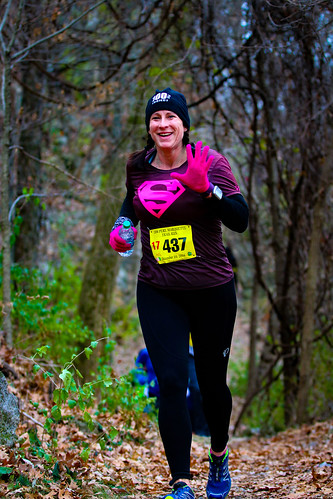 |
| Photo credit: Robin Misukonis |
I'd heard them for a while as I was closing in, their loud and easy camaraderie reminding me of my Virtus teammates. We played leapfrog for a while, me getting ahead on flats and downhills, only to be passed with authority any time the trail began to climb. The opposite happened with my friend Gary, who for a while I kept catching on uphills after he'd smoked me on the descent. Eventually, though, he pulled ahead and I didn't see him until the finish line.
The first three miles felt like kind of a slog. Struggling on uphills (though Strava tells me I PR'd the first two big hill segments, which is probably more of a comment on my previous races than anything) was unsurprising; of course, flats didn't feel much better and lacked the built-in excuse to walk.
I wasn't unhappy, but I wasn't particularly having fun either. Still, occasional glances at my Garmin showed paces in the 12 min/mile range, which isn't much slower than the speed of my occasional flat, paved neighborhood road runs. Rather than a total trainwreck, my exertion-impaired math skills suggested I had a good chance of a PR, though the likelihood diminished when I remembered that the race wasn't 6 miles but nearly 8.
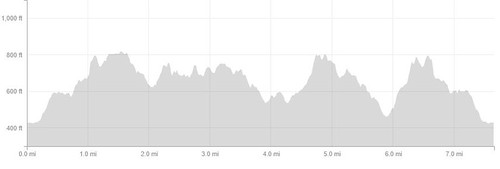 |
| PMETR elevation |
Regardless, by the midpoint of the race my countdown had shifted from how much more I had to get through to how much race was left, the mental lightness aided by a largely downhill mile. On the other hand, while my lack of run training hadn't totally ruined my conditioning, it had successfully erased everything I used to know about fueling during a run. My 6 a.m. oatmeal was a distant memory, and I hadn't though to bring a mid-race gel. I'd expected the mile 3 water stop to have candy and was sorely disappointed.
Thankfully there was candy at the mile 5ish water stop, where I stopped long enough to grab an orange slice and 4 mini Reese's to eat as I ran. From there, the course swept downhill to the road crossing and final climb. That last uphill was brutal; even walking was difficult. I glanced nervously at my Garmin, wincing at the pace I saw. I thought I still had a chance to PR, but it wasn't a sure thing.
A man came up behind me and I kept asking, "Do you want to get past? Are you sure you don't want to pass me?" He didn't take me up on the offer until we hit the top of the climb. There a volunteer assured us that we only had one mile left. I'm not so sure about that, I thought, but I liked the way it sounded.
One little climb stood between me and the downhill run to the finish line. I ran that as best I could -- more of an approximation of a run -- and then sped up as soon as the uphill ended. I saw Cassie and Amie cheering on the side of the trail, and I saw the 1-mile mark we'd passed on the outward leg of the race (I knew that guy was wrong). I passed back the man who'd trailed me up the last hill, only to have to make a quick stop to fix my dangling shoelace.
I knew Robin would be set up to take pictures of racers coming through the rocks. Every year she gets some really cool shots of other people, and every year I tiptoe through like someone's arthritic grandmother. This was no exception.
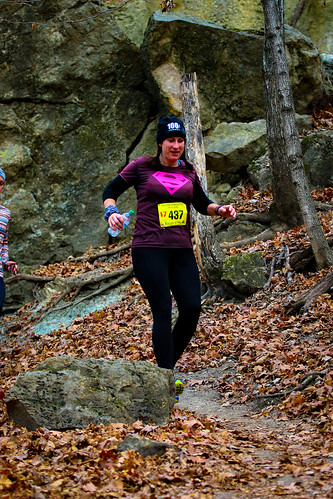 |
| Looks like I have my race-walking form down! Photo credit; Robin Misukonis |
Once you clear that rockier area, the trail is more runnable, and I tried to push the pace. I caught up with Jody, who's had a similar case of riding-bikes-is-more-fun-than-running. "Seems like we meet up at this spot every year," he commented. I slowed again as I reached the water bars along the last section of downhill. Between rocks, uneven drops, and the cross-ties, it always looks like trouble to me. As soon as I hit the final flat, though, it was on.
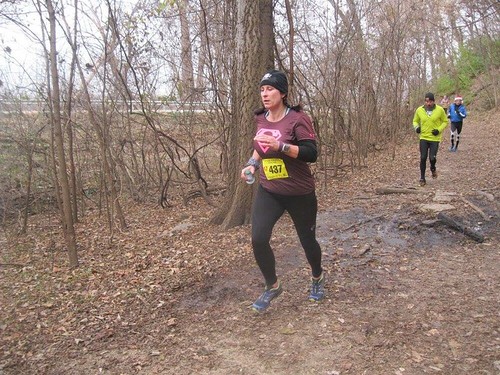 |
| A guy in front of me had just picked his way through the mud so as not to get his feet wet .2 miles before the end of the race. |
I sprinted with as much sprint as I had left, hearing the finish line cowbells and just trying to hold on until I crossed. I did manage to pass a couple of guys right before the finish. I was pretty sure my PR was 1:35, so I was excited to see my time of 1:32:07, an improbable but unmistakable new PR. I was astonished and thrilled. On a day I'd had no goal except not dying I was going home with a 3 minute PR.
I was slightly deflated when I later looked back at previous results and realized my fastest time was actually 1:30 and this year's time was actually my third best. But only slightly. Misremembered times aside, I'd done far better than I'd have even thought to hope. I thought back over the race, wondering if there were places I'd given away two minutes' worth of time. There were one or two spots I could have started running a hair sooner, but in the end I don't think -- given the fitness I currently have -- I could realistically have cut enough time off of my day to PR.
Of course, stronger than expected performance on minimal training reawakens the eternal question: how well could I do if I actually trained for this race? Maybe next year I'll find out.
And the cycle begins again...
1:32:07
25/36 AG
107/195 women
404/556 overall
I was slightly deflated when I later looked back at previous results and realized my fastest time was actually 1:30 and this year's time was actually my third best. But only slightly. Misremembered times aside, I'd done far better than I'd have even thought to hope. I thought back over the race, wondering if there were places I'd given away two minutes' worth of time. There were one or two spots I could have started running a hair sooner, but in the end I don't think -- given the fitness I currently have -- I could realistically have cut enough time off of my day to PR.
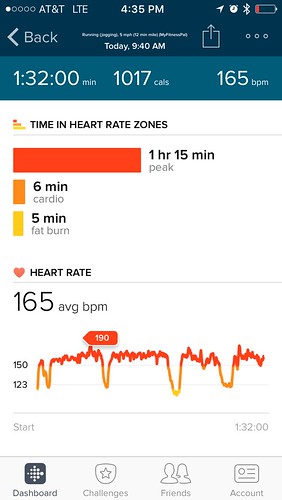 |
| I think my Fitbit would tend to agree with that assessment. |
And the cycle begins again...
1:32:07
25/36 AG
107/195 women
404/556 overall
Comments
Post a Comment